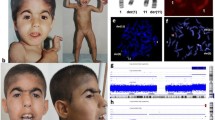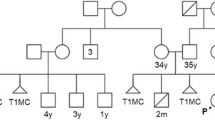Abstract
Background
Chromosomal abnormality is a common cause of congenital anomalies, psychiatric disorders, and mental retardation. However, the double trisomy 48,XXX,+18 is a rare chromosome abnormality.
Methods
Case report and literature review.
Results
A 7-hour-old girl presented to our unit because of poor response after birth. She presented with multiple dysmorphic features, including small for gestational age infant, flat nasal bridge, widely-spaced eyes, the left thumb deformities, flat facial profile, raised sternum, ventricular septal defect, the third lateral brain ventricle enlargement, and small liver. This case expands the spectrum of malformations reported in association with the double trisomy 48,XXX,+18. The literature on 16 fetuses or infants with the 48,XXX,+18 were also reviewed.
Conclusion
These data suggested that in patients with clinical features similar to trisomy 18, especially with anomalies of the ears and/or reproductive malformations, double trisomy (48,XXX,+18) should be considered and karyotyping should be performed although it is a rare disease.
Similar content being viewed by others
References
Xu F, Zou CC, Liang L, Huang XM, Shao YN. Ring chromosome 15 syndrome: case report and literature review. HK J Paediatr (New series) 2011;16:175–179.
Huang XY, Tang LF, Zou CC, Zhao ZY. Chromosome analysis in 8158 pediatric patients: an experiment of 29 years from Hangzhou, China. Endocrinologist 2010;20:179–181.
Cereda A, Carey JC. The trisomy 18 syndrome. Orphanet J Rare Dis 2012;7:81.
Otter M, Schrander-Stumpel CT, Didden R, Curfs LM. The psychiatric phenotype in triple X syndrome: new hypotheses illustrated in two cases. Dev Neurorehabil 2012;15:233–238.
Ljunger E, Cnattingius S, Lundin C, Annerén G. Chromosomal anomalies in first-trimester miscarriages. Acta Obstet Gynecol Scand 2005;84:1103–1107.
Ohno M, Maeda T, Matsunobu A. A cytogenetic study of spontaneous abortions with direct analysis of chorionic villi. Obstet Gynecol 1991;77:394–398.
Shen Z, Zou CC, Shang SQ, Jiang KW. Down-Klinefelter syndrome (48,XXY,+21) in a child with congenital heart disease: case report and literature review. Intern Med 2012;51:1371–1374.
Hall H, Hunt P, Hassold T. Meiosis and sex chromosome aneuploidy: how meiotic errors cause aneuploidy; how aneuploidy causes meiotic errors. Curr Opin Genet Dev 2006;16:323–329.
Hassold T, Hall H, Hunt P. The origin of human aneuploidy: where we have been, where we are going. Hum Mol Genet 2007;16:R203–R208.
Diego-Alvarez D, Ramos-Corrales C, Garcia-Hoyos M, Bustamante-Aragones A, Cantalapiedra D, Diaz-Recasens J, et al. Double trisomy in spontaneous miscarriages: cytogenetic and molecular approach. Hum Reprod 2006;21:958–966.
Uchida IA, Bowman JM. XXX 18-Trisomy. Lancet 1961;2:1904.
Uchida IA, Lewis AJ, Bowman JM, Wang HC. A case of double trisomy: trisomy No. 18 and triplo-X. J Pediatr 1962;60:498–502.
Uchida IA, Bowman JM, Wang HC. The 18-trisomy syndrome. N Engl J Med 1962;266:1198–1201.
Ricci N, Borgatti L. XXX 18-Trisomy. Lancet 1963;2:1276–1277.
Haas L, Lewis FJ. Double trisomy: trisomy 17–18 with triple X in a female infant. J Pediatr 1966;69:660–662.
Engel E, Haddow JE, Lewis JF, Tipton RE, Overall JC, McGee BJ, et al. Three unusual trisomic patterns in children. Triple X plus triple E-triple X mosaic: normal XY-D trisomy mosaic; partial trisomy with E translocation. Am J Dis Child 1967;113:322–328.
Madahar DP, Dosik H, Wexler I. 48,XXX, plus 18 double trisomy. J Med Genet 1974,11:309–311.
Rosenfeld W, Verma RS, Jhaveri RC, Salazar D, Dosik H. Double trisomy 48,XXX,+ 18 in a newborn. Am J Med Genet 1981;8:67–71.
Imai I, Shimao S, Suzuki Y, Okada T. A case of 48,XXX, +18 double trisomy. Acta Paediatr Jpn 1987;29:178–181.
Sonoda T, Ohdo S, Madokoro H, Akimoto K, Ohba K. Clinical and postmortem findings of two cases with karyotype: 48,XXX, +18. Acta Paediatr Jpn 1987;29:173–177.
Jaruratanasirikul S, Jinorose U. An infant with double trisomy (48,XXX, + 18). Am J Med Genet 1994;49:207–210.
Tsukahara M, Fukuda M, Furukawa S, Kondoh O. Double trisomy (48,XXX, +18). Am J Med Genet 1994;52:244.
Chen CP, Chern SR, Yeh LF, Chen WL, Chen LF, Wang W. Prenatal diagnosis and genetic analysis of double trisomy 48,XXX,+18. Prenat Diagn 2000;20:750–753.
van Huizen ME, Knegt AC, Bijlsma EK, Bilardo CM. Double trisomy 48,XXX,+18 in association with increased nuchal translucency; two cases. Prenat Diagn 2004;24:1020–1021.
Dezerega V, Be C, Wong AE, Silva R, Sepulveda W. Prenatal diagnosis of double trisomy 48,XXX,+18 in the first trimester. J Ultrasound Med 2005;24:717–719.
Tartaglia NR, Howell S, Sutherland A, Wilson R, Wilson L. A review of trisomy X (47,XXX). Orphanet J Rare Dis 2010;5:8.
De Souza E, Morris JK, Eurocat Working Group. Case-control analysis of paternal age and trisomic anomalies. Arch Dis Child 2010;95:893–897.
Otter M, Schrander-Stumpel CT, Curfs LM. Triple X syndrome: a review of the literature. Eur J Hum Genet 2010;18:265–271.
Kelkar A, Deobagkar D. Methylation profile of genes on the human X chromosome. Epigenetics 2010;5:612–618.
Author information
Authors and Affiliations
Corresponding author
Rights and permissions
About this article
Cite this article
Jiang, ZY., Wu, XH. & Zou, CC. Double trisomy 48,XXX,+18 with multiple dysmorphic features. World J Pediatr 11, 83–88 (2015). https://doi.org/10.1007/s12519-015-0005-7
Received:
Accepted:
Published:
Issue Date:
DOI: https://doi.org/10.1007/s12519-015-0005-7




